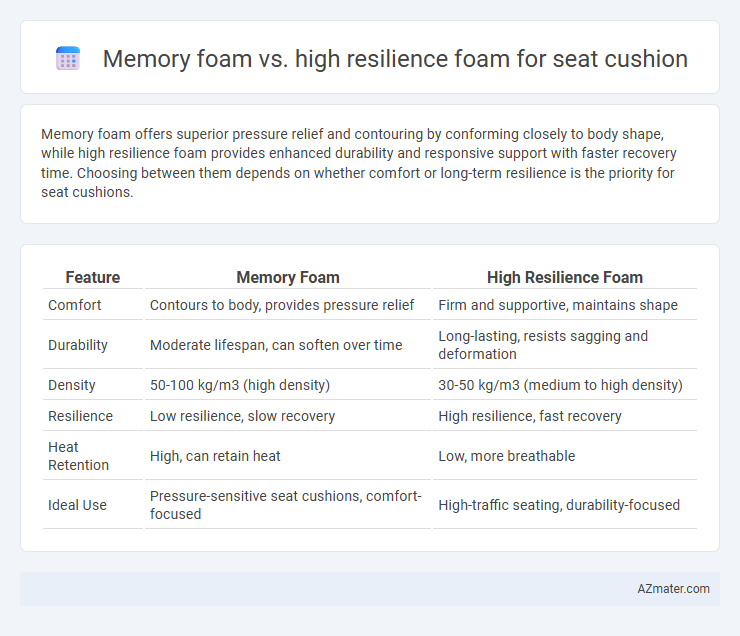Memory foam offers superior pressure relief and contouring by conforming closely to body shape, while high resilience foam provides enhanced durability and responsive support with faster recovery time. Choosing between them depends on whether comfort or long-term resilience is the priority for seat cushions.
Table of Comparison
| Feature | Memory Foam | High Resilience Foam |
|---|---|---|
| Comfort | Contours to body, provides pressure relief | Firm and supportive, maintains shape |
| Durability | Moderate lifespan, can soften over time | Long-lasting, resists sagging and deformation |
| Density | 50-100 kg/m3 (high density) | 30-50 kg/m3 (medium to high density) |
| Resilience | Low resilience, slow recovery | High resilience, fast recovery |
| Heat Retention | High, can retain heat | Low, more breathable |
| Ideal Use | Pressure-sensitive seat cushions, comfort-focused | High-traffic seating, durability-focused |
Introduction to Seat Cushion Materials
Memory foam offers superior contouring and pressure relief by adapting closely to body shape, making it ideal for prolonged seating comfort. High resilience foam provides durable support with excellent bounce-back properties, ensuring seat cushions maintain their shape and firmness over time. Choosing between memory foam and high resilience foam depends on the balance between pressure comfort and long-term structural support required in seat cushions.
What is Memory Foam?
Memory foam is a viscoelastic polyurethane material known for its high density and slow recovery properties, providing excellent pressure relief and contouring to body shapes. It absorbs and distributes weight evenly, making it ideal for seat cushions that require superior comfort and support. In comparison, high resilience foam offers quicker bounce-back and firmer support but lacks the same level of adaptive cushioning as memory foam.
What is High Resilience Foam?
High resilience foam is a durable, flexible polyurethane foam known for its superior support and rapid recovery after pressure. It offers excellent breathability and maintains shape longer than traditional memory foam, making it ideal for seat cushions that require both comfort and resilience. While memory foam conforms closely to body contours for pressure relief, high resilience foam provides more consistent support and enhanced longevity in seating applications.
Comfort Comparison: Memory Foam vs High Resilience Foam
Memory foam offers superior pressure relief and body contouring, enhancing comfort by evenly distributing weight and reducing pressure points. High resilience foam provides excellent support and durability with a responsive bounce, maintaining firmness over time but with less contouring effect than memory foam. For seat cushions, memory foam excels in personalized comfort, while high resilience foam is better suited for those seeking a firmer, more supportive seating experience.
Durability and Longevity
Memory foam seat cushions offer excellent pressure relief and conform to body contours but tend to compress and lose shape over time, impacting durability. High resilience foam is known for its robust cell structure, providing superior bounce-back ability and maintaining firmness longer, which enhances longevity. When prioritizing durability and long-term comfort, high resilience foam cushions generally outperform memory foam in retaining their original support and shape.
Support and Pressure Relief
Memory foam offers superior pressure relief by conforming closely to body contours, evenly distributing weight to reduce pressure points. High resilience foam provides enhanced support through its durable, buoyant structure, maintaining firmness and promoting proper posture over extended use. Both materials optimize comfort, but memory foam excels in contouring softness while high resilience foam prioritizes long-lasting support and resilience.
Heat Retention and Breathability
Memory foam seat cushions exhibit higher heat retention due to their dense structure, which molds to the body but restricts airflow, often causing discomfort in warm conditions. High resilience foam offers superior breathability with its open-cell design, promoting better air circulation and heat dissipation to maintain a cooler seating experience. Choosing between the two depends on prioritizing contouring comfort with potential heat buildup or enhanced ventilation with firmer support.
Price and Value for Money
Memory foam seat cushions typically cost more due to their pressure-relieving properties and contouring comfort, offering excellent value for individuals seeking long-term support. High resilience foam cushions are more affordable and provide durable, firm support with faster response to weight changes, making them suitable for budget-conscious buyers prioritizing longevity. Evaluating price alongside durability and comfort helps determine the best value for money based on personal seating needs.
Best Applications for Each Foam Type
Memory foam excels in seat cushions where pressure relief and contouring support are essential, making it ideal for long-duration seating in office chairs and ergonomic furniture. High resilience foam is best suited for applications demanding durability and quick recovery, such as automotive seating and high-use commercial furniture. Selecting the right foam ensures optimal comfort and longevity based on specific seating requirements.
Conclusion: Choosing the Right Foam for Your Seat Cushion
Memory foam offers superior contouring and pressure relief, making it ideal for those seeking personalized comfort and pain reduction in seat cushions. High resilience foam provides excellent durability, support, and bounce, suitable for users requiring long-lasting firmness and quick recovery. Selecting the right foam depends on whether your priority is customized comfort or robust, enduring support for everyday seating.

Infographic: Memory foam vs High resilience foam for Seat cushion
 azmater.com
azmater.com